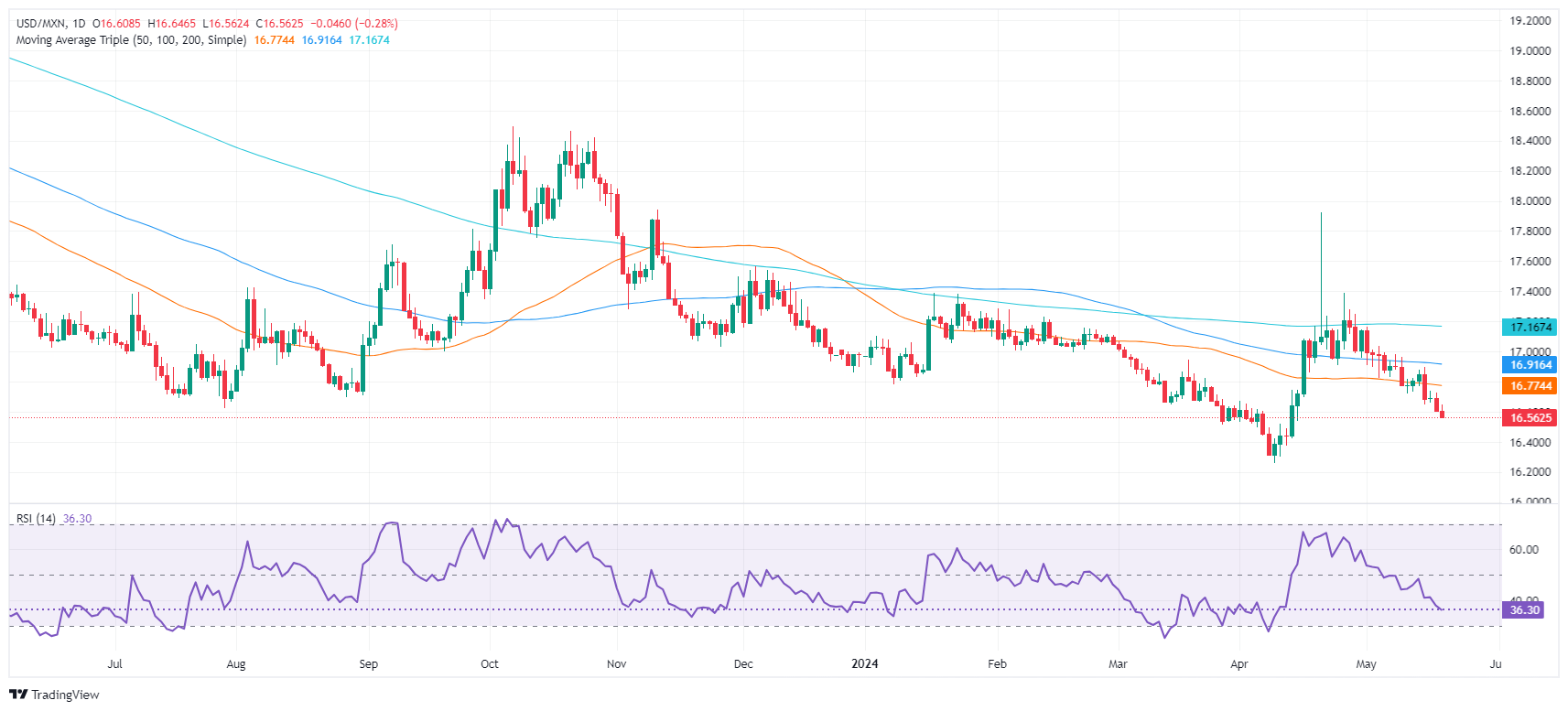- The Mexican Peso rises 0.26% against the US Dollar and falls below 16.60.
- The March retail sales figures from the INEGI were weak, while the GDP figures for the first quarter and the Banxico Minutes are approaching.
- The aggressive stance of Irene Espinosa, deputy governor of Banxico, contrasts with the US Fed's cautious optimism about disinflation.
The Mexican Peso posted solid gains against the US Dollar in early trading on Monday during the North American session. Despite weak retail sales data in Mexico, the Mexican currency advanced following comments from Vice Governor Irene Espinosa last Friday. The USD/MXN pair is trading at 16.56, down 0.26%.
Mexico's economic agenda will be more intense than last week. On Monday, the National Institute of Statistics, Geography and Informatics (INEGI) revealed that retail sales in March fell short of the mark in monthly and annual figures.
The data is released before Gross Domestic Product (GDP) figures for the first quarter of 2024 are released on May 23. These figures are expected to show that the Mexican economy is slowing amid higher costs debt of 11.00% set by the Bank of Mexico (Banxico) due to fear of higher inflation and a depreciation of the Peso.
That same day, Banxico will publish the Minutes of its last monetary policy meeting, followed on Friday by the announcement of the trade balance and current account.
Last Friday, Banxico Deputy Governor Irene Espinosa, the dissident from the last meeting, made hawkish comments claiming that the March rate cut was premature and would make it difficult for inflation to converge toward the bank's target.
Across the border, Federal Reserve Vice Chairman Philipp Jefferson said rate policy is restrictive and added that April's reading is encouraging. However, it is too early to know whether the disinflationary process will be lasting.
Daily summary of market movements: The Mexican peso soars after Irene Espinosa's aggressive stance
- March retail sales fell -0.2% month-on-month, down from February's 0.5% increase. On a year-over-year basis, sales plunged -1.7%, below estimates of 0%, and below the previous month's 3% growth.
- Divergent opinions emerge in Banxico. Governor Victoria Rodríguez Ceja declared last Monday that the bank would debate the rate cut at the next meeting on June 29. On the contrary, Deputy Governor Irene Espinosa commented that lowering rates in March could have delayed the convergence of inflation towards the central bank's objective by two quarters.
- According to Bloomberg, leveraged funds increased their net long positions in pesos by 3,780 contracts between May 7 and 14 via CFTC data. Institutional asset managers, who maintain the largest bullish position in the peso with 146,975 contracts, also added to the positive momentum with 2,558 long peso contracts in the same week. This has propelled the Mexican Peso to be the best performing currency in the world to date.
- Atlanta Fed President Raphael Bostic said interest rates are likely to remain higher than they have been in the past decade, adding that the Fed is open to all possibilities amid many economic scenarios.
- Chicago Board of Trade data shows investors expect 33 basis points (bps) of Fed easing by the end of the year, down from 35 bps on Friday.
Technical Analysis: Mexican Peso Extends Gains as USD/MXN Falls Below 16.60
The Mexican Peso continues to rise strongly as the USD/MXN bearish trend extends, which is likely to test the psychological figure of 16.50. The RSI favors sellers, however, they seem to take a pause as the downward movement stalled.
Once USD/MXN falls below 16.50, the next stop would be the current year-to-date low of 16.25.
Conversely, if buyers reclaim the 50-day SMA at 16.76, it could exacerbate a rally towards the 100-day SMA at 16.91. Once surpassed, the next supply zone would be the psychological level of 17.00. In that case, the next stop would be the 200-day SMA at 17.17.
Frequently Asked Questions about the Mexican Peso
What is MXN?
The Mexican Peso is the legal tender of Mexico. The MXN is the most traded currency in Latin America and the third most traded on the American continent. The Mexican Peso is the first currency in the world to use the $ sign, prior to the later use of the Dollar. The Mexican Peso or MXN is divided into 100 cents.
What is Banxico and how does it influence the MXN?
Banxico is the Bank of Mexico, the country's central bank. Created in 1925, it provides the national currency, the MXN, and its priority objective is to preserve its value over time. In addition, the Bank of Mexico manages the country's international reserves, acts as a lender of last resort to the banks and advises the government economically and financially. Banxico uses the tools and techniques of monetary policy to meet its objective.
How does inflation impact the MXN?
When inflation is high, the value of the Mexican Peso (MXN) tends to decrease. This implies an increase in the cost of living for Mexicans that affects their ability to invest and save. At a general level, inflation affects the Mexican economy because Mexico imports a significant amount of final consumption products, such as gas, fuel, food, clothing, etc., and a large amount of production inputs. On the other hand, the higher the inflation and debt, the less attractive the country is for investors.
How does the Dollar influence the Mexican Peso (MXN)?
The exchange rate between the USD and the MXN affects imports and exports between the United States and Mexico, and may affect demand and trade flows. The price of the Dollar against the Mexican Peso is affected by factors such as monetary policy, interest rates, the consumer price index, economic growth and some geopolitical decisions.
How does the Fed's monetary policy affect Mexico?
The exchange rate between the USD and the MXN affects imports and exports between the United States and Mexico, and may affect demand and trade flows. The price of the Dollar against the Mexican Peso is affected by factors such as monetary policy, interest rates, the consumer price index, economic growth and some geopolitical decisions.
Source: Fx Street
I am Joshua Winder, a senior-level journalist and editor at World Stock Market. I specialize in covering news related to the stock market and economic trends. With more than 8 years of experience in this field, I have become an expert in financial reporting.








